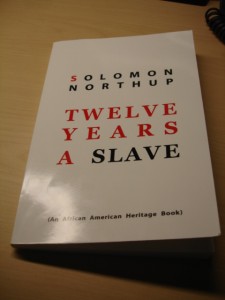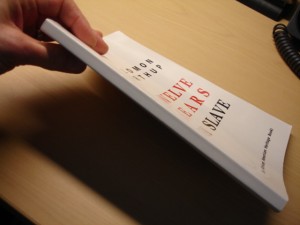In class last week and this, we are reading Twelve Years a Slave. It’s part of the slave narrative genre that was so popular back in the waning days of slavery (all the cool abolitionists were reading them). Unlike other slave narratives of the time (I’m thinking of Frederick Douglass’ memoir and Uncle Tom’s Cabin), though, no one much reads this book by Solomon Northup anymore. Admittedly, I hadn’t even heard of it until the first day of class when I saw it on the syllabus and then went and bought my very own copy.
This is the third book we’ve read so far this semester and it’s my favorite so far. Unlike Douglass’ book (which is awesome), Northup’s tale begins with his freedom. That’s right, he was born and raised a free man in New York. But one day, he was drugged and captured and spent a certain number of years (I won’t say how many, because I don’t want to spoil it for you) in indentured servitude, longing for the day when he’d be reunited with his wife and three children. In a way, then, Douglass’ book takes us on a long rise from despair to hope, while Northup’s follows a curve down to despair, and then back up. Douglass’ book is better written; Northup’s first chapter, in particular, is a boring list of facts and he frequently ruins any chance at surprise and foreshadowing the plot would otherwise have. He also revels in regaling us with details into the life of pretty much everyone he ever passes on the street, for Christ’s sake. Still, it’s a great story that needed to be told, it has a killer subtitle (Narrative of Solomon Northup, a citizen of New-York, kidnapped in Washington city in 1841, and rescued in 1853, from a cotton plantation near the Red River in Louisiana – beat that, Douglass!), and I am eagerly anticipating the movie (Brad Pitt, presumably, will not be playing the role of Northrup).
Anyway, I think the best way to demonstrate just how forgotten this work is, is to show you pictures of the piss-poor manner in which this book is published.
Okay, here’s the cover. Borrrring!
I keep trying to figure out the significance of the colors – black on white? With red? A red S? Does any of this mean anything? Nope. Notice the publisher put their name in parenthesis – yeah, I would too if I published books that looked this boring (and if my books had spelling and punctuation mistakes on every page, which this one has aplenty). What’s even funnier is that the title page lists a credit for the cover photo. Don’t you see the photo? It must be a photo of a glass of milk on a paper plate in a snowstorm.
Here’s the back cover. I know you probably can’t read it, but it’s mostly one big paragraph that the publisher spent about three minutes writing. The publisher tries to drum up excitement for this book by asserting that you should read this book because – get this: other people have read the book, and they are able to recall the fact that they’ve read it! Don’t believe me? Here’s what it says:
“Scholars reference this work today’ one example is Jesse Holland, who referred to him in an interview given on January20, 2009 on Democracy.now. He did so because Northrup’s extremely detailed description of Washington in 1841 helps the neuromancers understand the location of some slave markets, and is an important part of understanding that African slaves built many of the monuments in Washington, including the Capitol and part of the original Executive Mansion.”
Yeah, if that’s not the crappiest endorsement for a book I’ve ever read, I don’t know what is. Is “neuromancer” really the best word they could use? Oh – and it’s in all-caps for ya’, too, so that helps.
And just to make sure no part of Northup’s amazing story gets the disrespect this publisher feels it deserves, here’s the spine:
Wait…what does that say? Does it say nothing at all? That will really be helpful when I place this on my bookshelf and then have absolutely no way of knowing which book it is. Is it entirely white? Huh. Maybe there is some symbolism there.




I don’t think the parenthetical note on the cover denotes the publisher. It seems this same comment is on the cover of other versions from different publishing houses.
Also, there are eight “in-stock” paperback versions of this book on Amazon (not counting the, newly published, illustrated version) of varying quality and style. Most include the original dedication to Harriet Beecher Stowe and a few even include essays from the editor, introductions from historians, and wonderfully written endorsements. The publishing dates of the versions listed on Amazon cover eight of the last ten years. Not exactly a “forgotten work.”
But wow, the version you have (the one being pushed by Amazon) stinks. I’ll have to remember to check out the different versions the next time I buy a public domain book from them. I guess I already realized that anyone can publish these books, but for some reason I thought Amazon would only choose to feature the better quality printings. This one isn’t even the cheapest. Maybe they prioritize by volume.
I snagged the term “forgotten” from my professor, which she used to describe the book on the first day of class. I assume she meant it relative other slave narratives. The upcoming movie may be the reason for the sudden resurgence of print copies, too.
The version I purchased was the only one available at the universtiy book store, so I did not have the opportunity to compare it with other versions. Actually, this book was sitting in a stack on the top shelf (my eye-level), so all I saw were about ten blank spines. I had to pick it up to verify it was the correct book.
I liked the text, but hate this version. I’ll probably sell this one back to the school store when the class is completed, then take my fifty cents and put it toward a superior version.
Most editions of the book (and, yes, there are a lot of crappy ones, as people try to take advantage of interest in Northup generated by the coming feature film) do not provide any additional information on Northup beyond what is in his narrative. One that does, and which I recommend, is the one from Louisiana State University Press. Editors Joseph Logsdon and Sue Eakin did some research on Northup. Also, see my book (Solomon Northup: His Life Before and After Slavery) for the afterstory. I maintain this web site: solomonnorthup.com.
David Fiske:
Thank you for the additional information. I enjoyed your site, and will look into those books. I have to write a paper for class (due next Thursday – 21Mar), and I plan to use Northup’s story heavily in my argument.